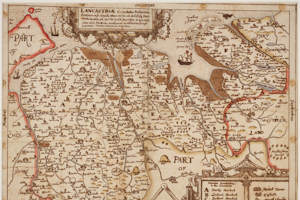Rare treasure made by Elizabethan mapmaker goes on display in Manchester
03 Dec 2014
A unique 17th century map of Lancashire recently found in The John Rylands Library has been placed on public display for the first time

This cartographic treasure, hand drawn by the Elizabethan Herald William Smith, is on show at The John Rylands Library, on Deansgate, this week until 22 December.
Dr Ian Saunders, a historian specialising in printed maps of Lancashire, believes that the map was made between 1602 and 1604. It was the final draft for a rare map of Lancashire which recently appeared in Dr Saunders’s book: Printed Maps of Lancashire: the first two hundred years.
Dr Saunders said: “It is a full size design for a copper plate to be engraved in Amsterdam by Jodocus Hondius, who was the finest map engraver of the period. This plate was intended for the printing of a map of Lancashire, almost certainly as part of a county atlas, but the plates for only 12 counties were produced and the atlas project never came to fruition. For the first fifty years of its existence the plate was not used.”
Smith’s maps were based on earlier ones by Saxton and Norden, but introduced additional features such as boundaries of the Hundreds into which counties were divided, extra place names and a table of symbols.
Dr Saunders continues: “It is thought that the county series was never completed due to Hondius taking on the commission for engraving a new atlas by John Speed, The Theatre of the Empire of Great Britain, which has been celebrated for 400 years as one of the world’s most popular cartographic treasures.
“Speed openly acknowledged his friend Smith’s influence on his own maps and it is probable that his publisher George Humble bought the twelve plates and stored them away to prevent their use for a competing publication.”
The 12 county maps drawn by Smith were previously known as the Anonymous Series and their origin was a cartographic mystery, which seemed impossible to solve for over 300 years.
Confirmation of Smith as the map-maker finally came in 1958, when four manuscript originals of Hertfordshire, Worcestershire, Warwickshire and Cheshire were discovered by Mr R. V. Tooley in Holland and acquired by the British Museum.
Dr Saunders said: “It is not known how the Lancashire map became separated from the manuscripts of the other four counties. It was bequeathed to the Library by Leonard Penna, who informed his friend Mr Alan Monks of its significance. Mr Monks recognised the printed version of the map when he saw it in my book.
“I was astounded when Mr Monks alerted me to the existence of the original drawing at the John Rylands Library.”
John Hodgson, a manuscripts and archives manager, and Donna Sherman, who is a map librarian at the Library, have worked with Dr Saunders to bring the map to light.
Dr Saunders said: “It is thrilling to be one of the very few people who had seen and handled this map during the past 400 years.”
